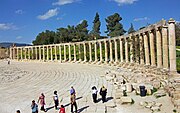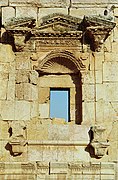Wakwakwiki (talk | contribs) You are not making any contribution, this is vandalism... you cannot just replace Souf with Sakib in every page you are editing |
Historyfeelings (talk | contribs) Undid revision 490899793 by Wakwakwiki (talk) |
||
| Line 51: | Line 51: | ||
'''Jerash''', the '''Gerasa''' of Antiquity, is the capital and largest city of [[Jerash Governorate]] ('''محافظة جرش'''), which is situated in the north of [[Jordan]], {{convert|48|km|mi}} north of the capital [[Amman]] towards Syria. Jerash Governorate's geographical features vary from cold mountains to fertile valleys from {{convert|250|to|300|m|ft}} above sea level, suitable for growing a wide variety of crops. |
'''Jerash''', the '''Gerasa''' of Antiquity, is the capital and largest city of [[Jerash Governorate]] ('''محافظة جرش'''), which is situated in the north of [[Jordan]], {{convert|48|km|mi}} north of the capital [[Amman]] towards Syria. Jerash Governorate's geographical features vary from cold mountains to fertile valleys from {{convert|250|to|300|m|ft}} above sea level, suitable for growing a wide variety of crops. |
||
Inhabitants of [[ |
Inhabitants of [[Sakib]] and other ancient villages in Jerash region were among the founders of the modern city of Jerash in the early nineteenth century,.<ref>Nies, J. B :Notes on across Jordan Trip, made October 23rd to November 7th, 1899, Palestine exploration fund, Quarterly statement, London, 1901</ref> A strong earthquake in 747 AD destroyed large parts of Jerash, while subsequent earthquakes along with the wars and turmoil contributed to additional destruction. Its destruction and ruins remained buried in the soil for hundreds of years until they were discovered by [[Germany|German]] [[Orientalist]] [[Ulrich Jasper Seetzen]] in 1806 AD <ref>Reisen, ed. Kruse, 4 vols, Berlin, 1854</ref> to begin excavation and to return life to rise to the current Jerash. Then followed 70 years after by the community of Muslims, Circassians, who emigrated to Jordan from the land of the Caucasus in 1878 AD after the Ottoman-Russian war. And a large community of people of Syria at the beginning of the twentieth century. |
||
==History== |
==History== |
||
| Line 87: | Line 87: | ||
[[Image:Oval plaza in Jerash.jpg|thumb|The oval [[Forum (Roman)|Forum]] ]] |
[[Image:Oval plaza in Jerash.jpg|thumb|The oval [[Forum (Roman)|Forum]] ]] |
||
Jerash has developed dramatically in the last century and the growing importance of the tourism industry to the city. Jerash is now the second-most popular tourist attraction in Jordan, closely behind the splendid ruins of [[Petra]]. The ruins have been carefully preserved and spared from encroachment, with the modern city sprawling to the west of ancient Jerash's city walls. |
Jerash has developed dramatically in the last century and the growing importance of the tourism industry to the city. Jerash is now the second-most popular tourist attraction in Jordan, closely behind the splendid ruins of [[Petra]]. The ruins have been carefully preserved and spared from encroachment, with the modern city sprawling to the west of ancient Jerash's city walls. |
||
[[ |
[[Sakib]] was the seed for modern Jerash. For many centuries, it was the center of the al-Meradh area during the [[Ottoman Empire]]. The Al-Meradh region was called this because it resisted the Bedouin looting attacks that used to be launched by Bedouin tribes. They led a resistance alliance which finally succeeded in defeating the Bedouin. Also took the name cause they objected to the oppression of the Ottoman rule during the stages of his crime. |
||
Jerash actually re-inhabited by the local people of [[ |
Jerash actually re-inhabited by the local people of [[Sakib]] and the surrounding villages who are now the vast majority of the city population. Later it became a destination for many successive waves of foreign migrants. The first wave started during the first half of the twentieth century when the [[Demographics of Syria|Syrians]] (Shwam) and the [[Circassians]] camped nearby the old ruins. The new immigrants have been welcomed by the local people and settled down in the city. Later, Jerash also witnessed waves of Palestinian refugees who flow to the city in 1948 and 1967. |
||
However, recently the city of Jerash has been expanded to include many of the surrounding villages including [[Souf]], Dairelliat, Thougretasfour, Jaba, Aljbarat and Majar. Other important villages in the governate include: Kitteh |
However, recently the city of Jerash has been expanded to include many of the surrounding villages including [[Sakib]], [[Souf]], Dairelliat, Thougretasfour, Jaba, Aljbarat and Majar. Other important villages in the governate include: Kitteh, Nahlé, Burma, Mustabah, Jubba, Raimoun, [[Kufr Khall]], Balila, and Qafqafa. |
||
Since 1981, the old city of Jerash has hosted the [[Jerash Festival]],<ref>[ http://www.jerashfestival.jo Jerash Festival Of Culture & Arts مهرجان جرش للثقافة والفنون]</ref> a three week long summer program of dance, music, and theatrical performances. The festival is frequently attended by members of the royal family of Jordan and is hailed as one of the largest cultural activities in the region. |
Since 1981, the old city of Jerash has hosted the [[Jerash Festival]],<ref>[ http://www.jerashfestival.jo Jerash Festival Of Culture & Arts مهرجان جرش للثقافة والفنون]</ref> a three week long summer program of dance, music, and theatrical performances. The festival is frequently attended by members of the royal family of Jordan and is hailed as one of the largest cultural activities in the region. |
||
| Line 124: | Line 124: | ||
==See also== |
==See also== |
||
[[File:Thedecapolis.png|thumb|upright|Map of the [[Decapolis]] showing location of Gerasa (Jerash)]] |
[[File:Thedecapolis.png|thumb|upright|Map of the [[Decapolis]] showing location of Gerasa (Jerash)]] |
||
* [[ |
* [[Sakib]] |
||
* [[Ajlun]] |
* [[Ajlun]] |
||
* [[Amman]] |
* [[Amman]] |
||
Revision as of 00:39, 6 May 2012
32°16′20.21″N 35°53′29.03″E / 32.2722806°N 35.8913972°E
Jerash
مدينة جرش Gerasa (Ancient Greek) | |
|---|---|
City | |
 The Roman city of Gerasa and the modern Jerash (in the background). | |
| Nickname(s): Pompeii of the East, The city of 1000 columns | |
| Country | Jordan |
| Province | Jerash Governorate |
| Founded | 2000 B.C. |
| Municipality established | 1910 |
| Government | |
| • Type | Municipality |
| Elevation | 600 m (1,968 ft) |
| Population (2003)[1] | |
| • Total | city (41,500) Municipality (150,000 est) |
| Time zone | GMT +2 |
| • Summer (DST) | +3 |
| Area code | +(962)2 |
| Website | http://www.jerash.gov.jo |

Jerash, the Gerasa of Antiquity, is the capital and largest city of Jerash Governorate (محافظة جرش), which is situated in the north of Jordan, 48 kilometres (30 mi) north of the capital Amman towards Syria. Jerash Governorate's geographical features vary from cold mountains to fertile valleys from 250 to 300 metres (820 to 980 ft) above sea level, suitable for growing a wide variety of crops.
Inhabitants of Sakib and other ancient villages in Jerash region were among the founders of the modern city of Jerash in the early nineteenth century,.[2] A strong earthquake in 747 AD destroyed large parts of Jerash, while subsequent earthquakes along with the wars and turmoil contributed to additional destruction. Its destruction and ruins remained buried in the soil for hundreds of years until they were discovered by German Orientalist Ulrich Jasper Seetzen in 1806 AD [3] to begin excavation and to return life to rise to the current Jerash. Then followed 70 years after by the community of Muslims, Circassians, who emigrated to Jordan from the land of the Caucasus in 1878 AD after the Ottoman-Russian war. And a large community of people of Syria at the beginning of the twentieth century.
History
Jerash is known for the ruins of the Greco-Roman city of Gerasa, also referred to as Antioch on the Golden River. It is sometimes misleadingly referred to as the "Pompeii of the Middle East or Asia", referring to its size, extent of excavation and level of preservation (though Jerash was never buried by a volcano). Jerash is considered one of the most important and best preserved Roman cities in the Near East. It was a city of the Decapolis.
Jerash was the home of Nicomachus of Gerasa (Greek: Νικόμαχος) (c. 60 – c. 120) who is known for his works Introduction to Arithmetic (Arithmetike eisagoge), The Manual of Harmonics and The Theology of Numbers.
Recent excavations show that Jerash was already inhabited during the Bronze Age (3200 BC - 1200 BC). After the Roman conquest in 63 BC, Jerash and the land surrounding it were annexed by the Roman province of Syria, and later joined the Decapolis cities. In AD 90, Jerash was absorbed into the Roman province of Arabia, which included the city of Philadelphia (modern day Amman). The Romans ensured security and peace in this area, which enabled its people to devote their efforts and time to economic development and encouraged civic building activity.
In the second half of the first century AD, the city of Jerash achieved great prosperity. In AD 106, the Emperor Trajan constructed roads throughout the provinces and more trade came to Jerash. The Emperor Hadrian visited Jerash in AD 129-130. The triumphal arch (or Arch of Hadrian) was built to celebrate his visit. A remarkable Latin inscription records a religious dedication set up by members of the imperial mounted bodyguard "wintering" there.
The city finally reached a size of about 800,000 square meters within its walls. The Persian invasion in AD 614 caused the rapid decline of Jerash. However, the city continued to flourish during the Umayyad Period, as shown by recent excavations. In AD 749, a major earthquake destroyed much of Jerash and its surroundings. During the period of the Crusades, some of the monuments were converted to fortresses, including the Temple of Artemis. Small settlements continued in Jerash during the Ayyubid, Mameluk and Ottoman periods. Excavation and restoration of Jerash has been almost continuous since the 1920s.
Ancient Jerash
Remains in the Greco-Roman Jerash include:
- The Corinthium column
- Hadrian's Arch
- The circus/hippodrome
- The two large temples (dedicated to Zeus and Artemis)
- The nearly unique oval Forum, which is surrounded by a fine colonnade,
- The long colonnaded street or cardo
- Two theatres (the Large South Theatre and smaller North Theatre)
- Two baths, and a scattering of small temples
- An almost complete circuit of city walls.
Most of these monuments were built by donations of the city's wealthy citizens. From AD 350, a large Christian community lived in Jerash, and between AD 400-600, more than thirteen churches were built, many with superb mosaic floors. A cathedral was built in the fourth century. An ancient synagogue with detailed mosaics, including the story of Noah, was found beneath a church.
Modern Jerash
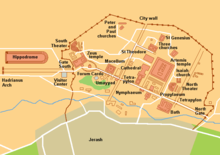

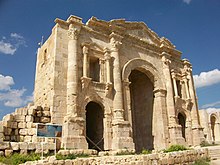
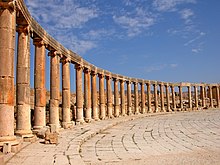
Jerash has developed dramatically in the last century and the growing importance of the tourism industry to the city. Jerash is now the second-most popular tourist attraction in Jordan, closely behind the splendid ruins of Petra. The ruins have been carefully preserved and spared from encroachment, with the modern city sprawling to the west of ancient Jerash's city walls.
Sakib was the seed for modern Jerash. For many centuries, it was the center of the al-Meradh area during the Ottoman Empire. The Al-Meradh region was called this because it resisted the Bedouin looting attacks that used to be launched by Bedouin tribes. They led a resistance alliance which finally succeeded in defeating the Bedouin. Also took the name cause they objected to the oppression of the Ottoman rule during the stages of his crime.
Jerash actually re-inhabited by the local people of Sakib and the surrounding villages who are now the vast majority of the city population. Later it became a destination for many successive waves of foreign migrants. The first wave started during the first half of the twentieth century when the Syrians (Shwam) and the Circassians camped nearby the old ruins. The new immigrants have been welcomed by the local people and settled down in the city. Later, Jerash also witnessed waves of Palestinian refugees who flow to the city in 1948 and 1967.
However, recently the city of Jerash has been expanded to include many of the surrounding villages including Sakib, Souf, Dairelliat, Thougretasfour, Jaba, Aljbarat and Majar. Other important villages in the governate include: Kitteh, Nahlé, Burma, Mustabah, Jubba, Raimoun, Kufr Khall, Balila, and Qafqafa.
Since 1981, the old city of Jerash has hosted the Jerash Festival,[4] a three week long summer program of dance, music, and theatrical performances. The festival is frequently attended by members of the royal family of Jordan and is hailed as one of the largest cultural activities in the region.
In addition performances of the Roman Army and Chariot Experience (RACE) were started at the hippodrome in Jerash. The show runs twice daily, at 11am and at 2pm, and at 10am on Fridays, except Tuesdays. It features forty-five legionaries in full armour in a display of Roman Army drill and battle tactics, ten gladiators fighting “to the death” and several Roman chariots competing in a classical seven lap race around the ancient hippodrome.
Demographics
According to the Jordan national census of 2004, the population of Jerash City was 31,650 and was ranked as the 14th largest municipality in Jordan. The estimated population in 2010 is about 42,000. The National census of 2004 showed that the population of the province of Jerash Governorate was 153,650.[5] 78,440 (51%) of the population was urban and 75,162 was rural. Jordanian citizens made up 87.1% of the population of Jerash Governorate. The male to female ratio was 51.48 to 48.51.[6] Jerash Governorate has the second highest density in Jordan (after Irbid Governorate).
Jerash has an ethnically diverse population, with the majority being Arabs. Circassians and Armenians also exist in a slightly larger percentage compared to other cities in Jordan. The majority of Jerash population are Muslims, however the percentage of Christians (Orthodox and Catholics) in Jerash city is also among the highest in Jordan.
Economy
Jerash economy depends largely on the tourists who visit the ancient city. It is also an agricultural city with more than 1.25 million olive trees in Jerash Governorate.[7] However, the location of Jerash, just half an hour ride from two of the largest cities in Jordan, Amman and Irbid, contributed to slowing down its development, as investments tend to go to the larger cities. Jerash Private University is the only university in Jerash located on the highway that connects Jerash to Amman, in the south eastern suburbs of the town.[8]
Gallery
-
The South Gate
-
Colonnade on the Roman Oval Forum
-
The cardo maximus
-
The South Theatre
-
The hippodrome
-
Enriched mouldings on the Temple of Artemis
-
Northern Tetrapylon
-
Mosaic at the Chistian Church
See also

References
- ^ http://www.jerash.gov.jo/aboutus1.aspx
- ^ Nies, J. B :Notes on across Jordan Trip, made October 23rd to November 7th, 1899, Palestine exploration fund, Quarterly statement, London, 1901
- ^ Reisen, ed. Kruse, 4 vols, Berlin, 1854
- ^ [ http://www.jerashfestival.jo Jerash Festival Of Culture & Arts مهرجان جرش للثقافة والفنون]
- ^ Jordan National Census, Arabic
- ^ Jordan Census Data 2004
- ^ Alrai Arabic
- ^ Jerash Private University
External links
- Wikitravel: Jerash
- BiblePlaces.com
- Jordan Tourism Board
- A brief history and some photographs
- Photos of Jerash
- 360 degrees panorama of Jerash
- Jerash on Jordanian Postage Stamps
- The Mosaics of Jerash
- Photos Jerash at Pasaporteblog.com Template:Es icon
- Jerash (Gerasa) - photo gallery
- Brown, J., E. Meyers, R. Talbert, T. Elliott, S. Gillies. "Places: 678158 (Gerasa/Antiochia ad Chrysorhoam)". Pleiades. Retrieved March 8, 2012.
{{cite web}}: CS1 maint: multiple names: authors list (link)

